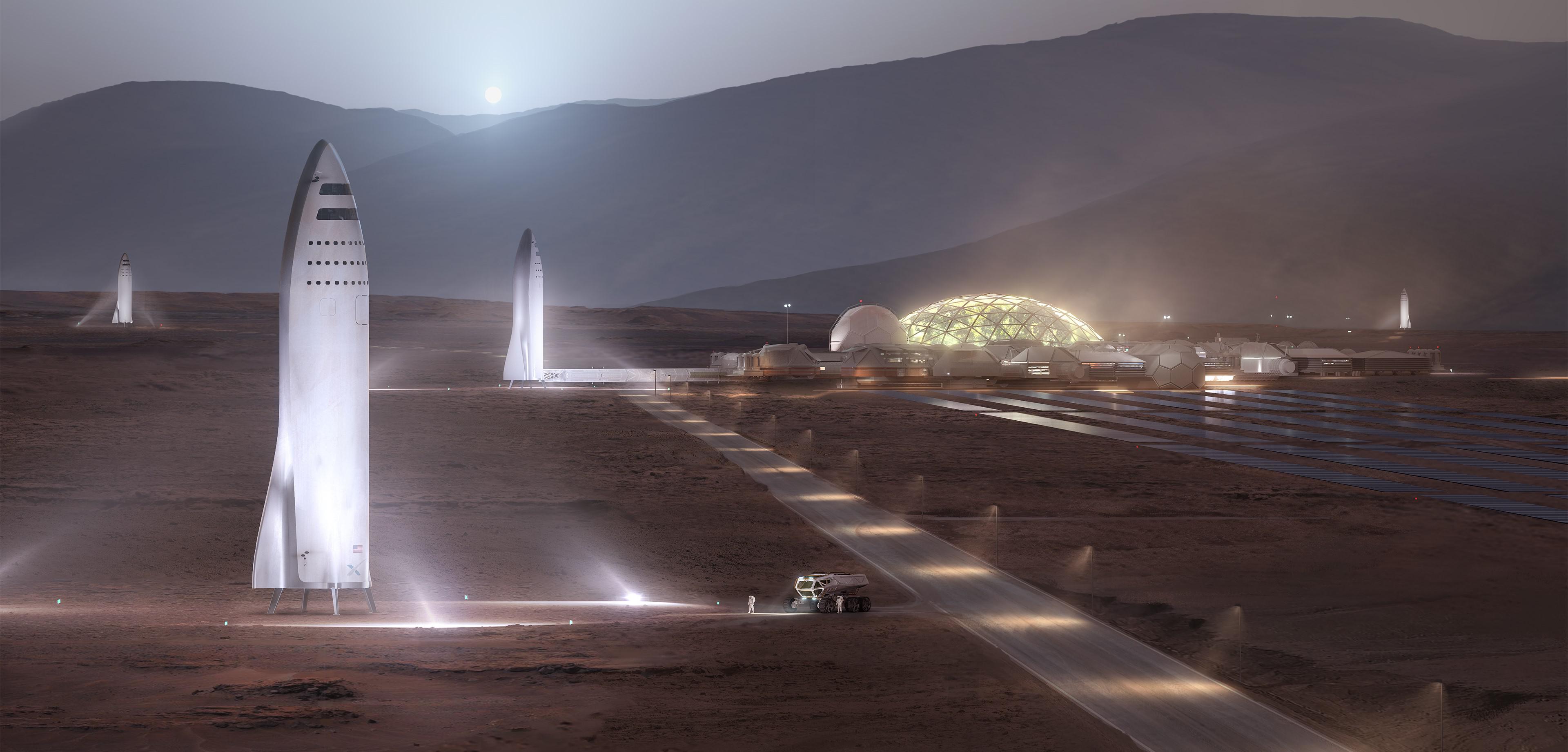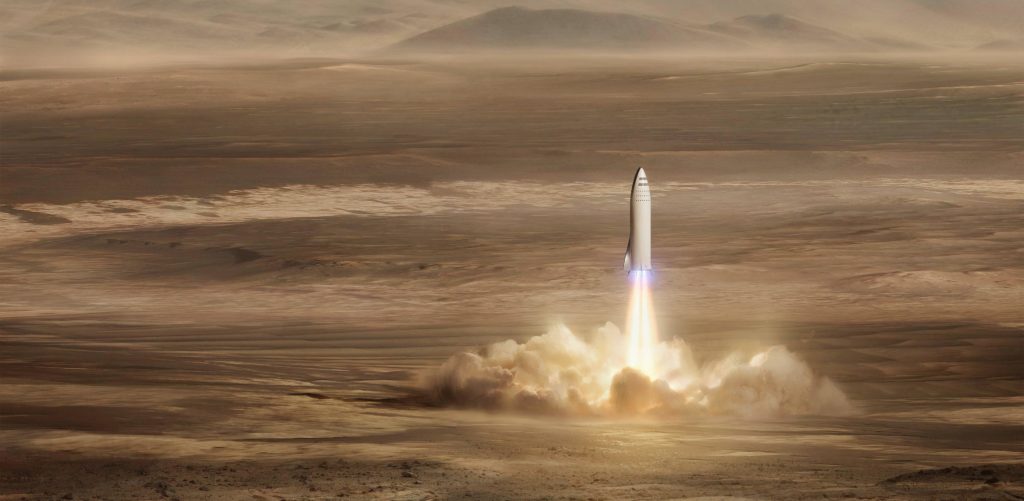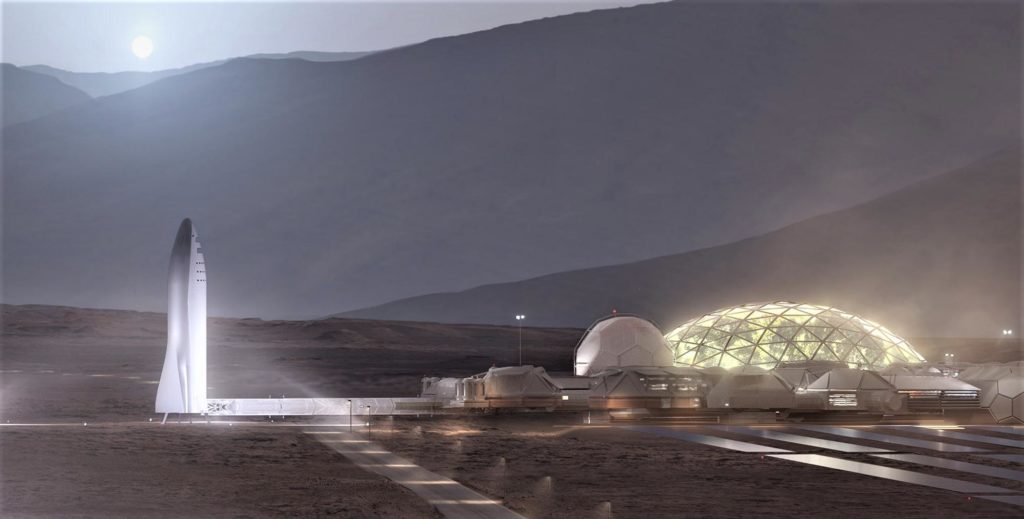

News
SpaceX wants to use the first Mars-bound BFR spaceships as Martian habitats
Speaking at the 2018 Mars Society Convention, SpaceX’s Principal Mars Development Engineer Paul Wooster briefly presented on the company’s BFR and Mars colony ambitions.
While the majority of the 30-minute talk rehashed CEO Elon Musk’s 2017 BFR update and subsequent Reddit AMA, it also happened to contain a handful of new details and slides, including a suggestion that the first BFR spaceships to land on Mars will stay on the Red Planet as temporary habitats or tools for early colonists.
SpaceX Mars architecture features pic.twitter.com/IHOLCbbvRS
— Maxime Lenormand (@MaxLenormand) August 25, 2018
The senior engineer reiterated the company’s aspirational Martian launch targets, featuring two uncrewed cargo BFRs in 2022 and four total BFRs in 2024, two crewed and two uncrewed. Whether or not the lack of change in those dates (provided by Wooster nearly a year after CEO Elon Musk’s identical date reveal in September 2017) asserts that SpaceX’s BFR and Mars research and development remains on track, it almost certainly confirms that the company’s incredibly aggressive targets are here to stay.
Graciously documented by Reddit users /u/theinternetftw and /u/Nehkara and European Space Agency intern Maxime Lenormand, at least partially alleviating the unbelievably atrocious webcast quality, Wooster offered attendees a slightly deeper glimpse into the extensive in-depth planning going on behind the scenes at SpaceX. Almost all of the new slides Wooster presented focused heavily on the technical side of actually planning to create a self-sustaining Martian colony, ranging from locations for any prospective colony to the types of skillsets that would be exceptionally invaluable in early colonists.
And here are some additional considerations pic.twitter.com/jdVJglfHCG
— Maxime Lenormand (@MaxLenormand) August 25, 2018
At this point, it’s entirely possible that SpaceX’s internal team of Mars-focused engineers and experts has already begun to approach or even surpass the detail and value of previous theoretical Martian colonization research from the likes of NASA, ESA, and other space agencies and companies. Still, SpaceX has made it eminently clear that it wants and likely needs to collaborate with independent experts on Mars, life support systems, construction, resource extraction and refinement, and more.
A private Mars workshop recently hosted by SpaceX – likely the first of many to come – evidenced that desire to collaborate with companies, agencies, and researchers that have already put years of effort into analyzing and answering the same questions SpaceX will need to answer to successfully build a sustainable city on Mars
- A Crew BFS (Big F____ Spaceship) pictured landing on Mars. (SpaceX)
- SpaceX’s Big F____ Spaceship (BFS) pictured near a conceptual Mars base, including a domed common area. (SpaceX)
Perhaps the most interesting detail to come out of Wooster’s August 25th talk, however, was the slight affirmation that SpaceX is seriously thinking about leaving the first landed BFR spaceships on Mars indefinitely, although it’s not entirely clear which spaceships he was referring to. According to paraphrased notes taken from the webcast, early BFR spaceships on the Martian surface would remain there to be used as resources (habitats). He subsequently noted that early colonists would “probably” live out of the first landed spaceships, to begin with, suggesting that the uncrewed, cargo-dedicated spaceships would still return to Earth, as they will not feature human-rated life support systems of any of the necessities for living.
Still, multiple other slides in Wooster’s presentation make it clear that the goal from the very beginning of the first BFRs to Mars is to expand living space and infrastructure as quickly as possible, paving the way for the arrival of more and more colonists. It’s extremely likely that a significant number of skilled colonists will be needed to ensure that the colony remains healthy and safe, while also guaranteeing that it can sustainably grow as rapidly as feasible.
Plans are for sending the first 2 cargos as soon as 2022! pic.twitter.com/A5y3HNpIOx
— Maxime Lenormand (@MaxLenormand) August 25, 2018
Even though it certainly wasn’t the “BFR update” Musk suggested was coming soon, Wooster’s presentation provided the best glimpse yet into the extensive analysis and planning SpaceX is undertaking to discern how exactly to best structure its very first colony-focused launches to Mars.
For prompt updates, on-the-ground perspectives, and unique glimpses of SpaceX’s rocket recovery fleet check out our brand new LaunchPad and LandingZone newsletters!
News
These Tesla, X, and xAI engineers were just poached by OpenAI
The news is the latest in an ongoing feud between Elon Musk and the Sam Altman-run firm OpenAI.

OpenAI, the xAI competitor for which Elon Musk previously served as a boardmember and helped to co-found, has reportedly poached high-level engineers from Tesla, along with others from xAI, X, and still others.
On Tuesday, Wired reported that OpenAI hired four high-level engineers from Tesla, xAI, and X, as seen in an internal Slack message sent by co-founder Greg Brockman. The engineers include Tesla Vice President of Software Engineering David Lau, X and xAI’s head of infrastructure engineering Uday Ruddarraju, and fellow xAI infrastructure engineer Mike Dalton. The hiring spree also included Angela Fan, an AI researcher from Meta.
“We’re excited to welcome these new members to our scaling team,” said Hannah Wong, an OpenAI spokesperson. “Our approach is to continue building and bringing together world-class infrastructure, research, and product teams to accelerate our mission and deliver the benefits of AI to hundreds of millions of people.”
Lau has been in his position as Tesla’s VP of Software Engineering since 2017, after previously working for the company’s firmware, platforms, and system integration divisions.
“It has become incredibly clear to me that accelerating progress towards safe, well-aligned artificial general intelligence is the most rewarding mission I could imagine for the next chapter of my career,” Lau said in a statement to Wired.
🚨Optimistic projections point to xAI possibly attaining profitability by 2027, according to Bloomberg's sources.
If accurate, this would be quite a feat for xAI. OpenAI, its biggest rival, is still looking at 2029 as the year it could become cash flow positive.💰 https://t.co/pE5Z9daez8
— TESLARATI (@Teslarati) June 18, 2025
READ MORE ON OPENAI: Elon Musk’s OpenAI lawsuit clears hurdle as trial looms
At xAI, Ruddarraju and Dalton both played a large role in developing the Colossus supercomputer, which is comprised of over 200,000 GPUs. One of the major ongoing projects at OpenAI is the company’s Stargate program,
“Infrastructure is where research meets reality, and OpenAI has already demonstrated this successfully,” Ruddarraju told Wired in another statement. “Stargate, in particular, is an infrastructure moonshot that perfectly matches the ambitious, systems-level challenges I love taking on.”
Elon Musk is currently in the process of suing OpenAI for shifting toward a for-profit model, as well as for accepting an investment of billions of dollars from Microsoft. OpenAI retaliated with a counterlawsuit, in which it alleges that Musk is interfering with the company’s business and engaging in unfair competition practices.
Elon Musk confirms Grok 4 launch on July 9 with livestream event
News
SpaceX share sale expected to back $400 billion valuation
The new SpaceX valuation would represent yet another record-high as far as privately-held companies in the U.S. go.

A new report this week suggests that Elon Musk-led rocket company SpaceX is considering an insider share sale that would value the company at $400 billion.
SpaceX is set to launch a primary fundraising round and sell a small number of new shares to investors, according to the report from Bloomberg, which cited people familiar with the matter who asked to remain anonymous due to the information not yet being public. Additionally, the company would sell shares from employees and early investors in a follow-up round, while the primary round would determine the price for the secondary round.
The valuation would represent the largest in history from a privately-owned company in the U.S., surpassing SpaceX’s previous record of $350 billion after a share buyback in December. Rivaling company valuations include ByteDance, the parent company of TikTok, as well as OpenAI.
Bloomberg went on to say that a SpaceX representative didn’t respond to a request for comment at the time of publishing. The publication also notes that the details of such a deal could still change, especially depending on interest from the insider sellers and share buyers.
Axiom’s Ax-4 astronauts arriving to the ISS! https://t.co/WQtTODaYfj
— TESLARATI (@Teslarati) June 26, 2025
READ MORE ON SPACEX: SpaceX to decommission Dragon spacecraft in response to Pres. Trump war of words with Elon Musk
SpaceX’s valuation comes from a few different key factors, especially including the continued expansion of the company’s Starlink satellite internet company. According to the report, Starlink accounts for over half of the company’s yearly revenue. Meanwhile, the company produced its 10 millionth Starlink kit last month.
The company also continues to develop its Starship reusable rocket program, despite the company experiencing an explosion of the rocket on the test stand in Texas last month.
The company has also launched payloads for a number of companies and government contracts. In recent weeks, SpaceX launched Axiom’s Ax-4 mission, sending four astronauts to the International Space Station (ISS) for a 14-day stay to work on around 60 scientific experiments. The mission was launched using the SpaceX Falcon 9 rocket and a new Crew Dragon capsule, while the research is expected to span a range of fields including biology, material and physical sciences, and demonstrations of specialized technology.
News
Tesla Giga Texas continues to pile up with Cybercab castings
Tesla sure is gathering a lot of Cybercab components around the Giga Texas complex.

Tesla may be extremely tight-lipped about the new affordable models that it was expected to start producing in the first half of the year, but the company sure is gathering a lot of Cybercab castings around the Giga Texas complex. This is, at least, as per recent images taken of the facility.
Cybercab castings galore
As per longtime drone operator Joe Tegtmeyer, who has been chronicling the developments around the Giga Texas complex for several years now, the electric vehicle maker seems to be gathering hundreds of Cybercab castings around the factory.
Based on observations from industry watchers, the drone operator appears to have captured images of about 180 front and 180 rear Cybercab castings in his recent photos.
Considering the number of castings that were spotted around Giga Texas, it would appear that Tesla may indeed be preparing for the vehicle’s start of trial production sometime later this year. Interestingly enough, large numbers of Cybercab castings have been spotted around the Giga Texas complex in the past few months.
Cybercab production
The Cybercab is expected to be Tesla’s first vehicle that will adopt the company’s “unboxed” process. As per Tesla’s previous update letters, volume production of the Cybercab should start in 2026. So far, prototypes of the Cybercab have been spotted testing around Giga Texas, and expectations are high that the vehicle’s initial trial production should start this year.
With the start of Tesla’s dedicated Robotaxi service around Austin, it might only be a matter of time before the Cybercab starts being tested on public roads as well. When this happens, it would be very difficult to deny the fact that Tesla really does have a safe, working autonomous driving system, and it has the perfect vehicle for it, too.
-

 Elon Musk1 week ago
Elon Musk1 week agoTesla investors will be shocked by Jim Cramer’s latest assessment
-

 News2 weeks ago
News2 weeks agoTesla Robotaxi’s biggest challenge seems to be this one thing
-

 Elon Musk1 day ago
Elon Musk1 day agoElon Musk confirms Grok 4 launch on July 9 with livestream event
-

 News2 weeks ago
News2 weeks agoWatch the first true Tesla Robotaxi intervention by safety monitor
-

 News5 days ago
News5 days agoTesla Model 3 ranks as the safest new car in Europe for 2025, per Euro NCAP tests
-

 Elon Musk2 weeks ago
Elon Musk2 weeks agoA Tesla just delivered itself to a customer autonomously, Elon Musk confirms
-

 Elon Musk2 weeks ago
Elon Musk2 weeks agoxAI welcomes Memphis pollution results, environmental groups push back
-

 Elon Musk2 weeks ago
Elon Musk2 weeks agoElon Musk confirms Tesla Optimus V3 already uses Grok voice AI



















